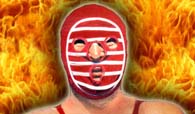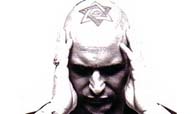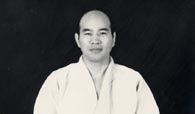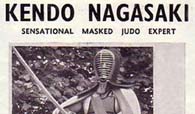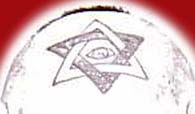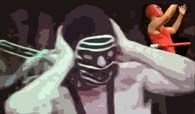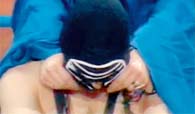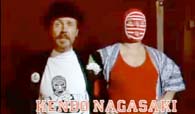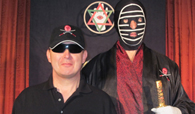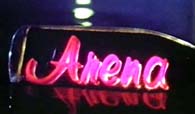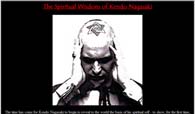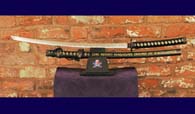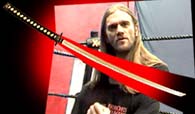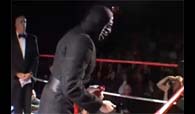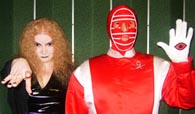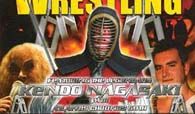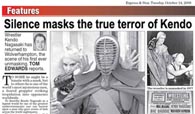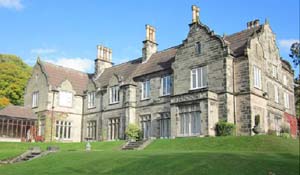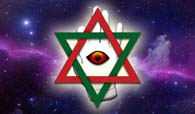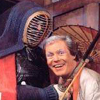
A one-time theatre manager...
...might hardly seem the most likely candidate to manage the most controversial wrestler of all time, but George Gillett actually fitted the bill most admirably... We were, after all, at the dawn of the age of glitz and glam rock, and the appearance of “Gorgeous George" was a perfectly-timed master-stroke. George’s outrageous costumes and make-up galvanised wrestling - never before had a man entered the ring decked out in feather boas, Elton John style glasses, and covered head to toe in any number of dazzling, sequinned outfits - from day one, George was Kendo's perfect sidekick. He had the patois too - from the moment that George first took the microphone, he let it be known that he was not satisfied with the standard of the opposition Nagasaki faced - George wanted ever bigger and better wrestlers to come forward to face the indestructible Samurai, and soon the whole business was on fire...
28th July 1971 marked Kendo's first television appearance, an event which should have come much sooner. Despite his very name assuring packed halls throughout the country, promoters had been reluctant to put Nagasaki on television because of his violent ring nature regularly ensuring his opposition ending up covered in blood; fearing that the television watchdogs would disapprove, they had long not dared to televise the edgy and dangerous Nagasaki. Finally, though, they relented, and collectively held their breaths as Kendo took on top heavyweight Billy Howes before the cameras at Catterick.
 It was indeed an explosive contest, both wrestlers colliding in fearsome combat as millions watched at home during the World of Sport Saturday afternoon ITV wrestling ritual. Such was the violence that Kendo’s was head cut open and blood and swelling were restricting his breathing; he half pulled mask off attempt to continue, but with Billy Howes intent on illegally unmasking him, Kendo himself fled into dressing room area, demanding be disqualified. Letters poured from viewers at home, not only commenting on the extraordinary man they had seen for first time from their armchairs, but also wanting see him again against other top wrestlers.
It was indeed an explosive contest, both wrestlers colliding in fearsome combat as millions watched at home during the World of Sport Saturday afternoon ITV wrestling ritual. Such was the violence that Kendo’s was head cut open and blood and swelling were restricting his breathing; he half pulled mask off attempt to continue, but with Billy Howes intent on illegally unmasking him, Kendo himself fled into dressing room area, demanding be disqualified. Letters poured from viewers at home, not only commenting on the extraordinary man they had seen for first time from their armchairs, but also wanting see him again against other top wrestlers.
This was the start of innumerable appearances on the small screen for Kendo Nagasaki, the mystery growing with every bout. Kendo’s salt ceremony at the beginning of each contest infuriated opponents and fans alike - Kendo has never been averse to making full use of his ceremonial salt whenever a ref’s back is turned. Although Kendo was largely hated by the great British public, he also inspired a strong and loyal following, so much so that a thriving fan club was set up in his name, and George became instrumental in replying to letters, sending out signed photos and generally keeping the fans informed of Nagasaki’s increasingly prestigious conquests.
The fans were not so keen when George informed them that for most of 1972 Kendo was going to be out of the country fighting in Canada and the USA. Working for Stu Hart’s Stampede Promotions all over North America, Kendo was just as successful abroad, and won the Stampede Heavyweight Championship belt. George was billed at this time as “Lord Sloane of Kensington Gore”, the promoter sensing that this title might well appeal to American audiences. He was right - Kendo and George became a sensation, creating the same havoc on any bill upon which they appeared as they had across the UK.
They returned home in the early days of 1973, and to mark the occasion, Kendo knocked out Big Daddy (Shirley Crabtree) in a televised contest to announce his return.  24 stone Big Daddy was gaining a strong following and a reputation for his belly-butts and strength moves, but Nagasaki’s experience won the day. Kendo’s speciality bout finisher was a move called the Kamakazi Crash, where he would hoist an unfortunate victim upon his shoulders in one corner of the ring before rolling forward on top of them in a ferocious crushing motion, bringing his full weight crashing down on their rib cage and stomach - inevitably the bout was over after such a dominating power move.
24 stone Big Daddy was gaining a strong following and a reputation for his belly-butts and strength moves, but Nagasaki’s experience won the day. Kendo’s speciality bout finisher was a move called the Kamakazi Crash, where he would hoist an unfortunate victim upon his shoulders in one corner of the ring before rolling forward on top of them in a ferocious crushing motion, bringing his full weight crashing down on their rib cage and stomach - inevitably the bout was over after such a dominating power move.
Another newcomer on the scene was also proving a great threat to Kendo, this was the 6’11” 31-stone Giant Haystacks, a bearded colossus from Salford. Daddy and Haystacks became tag partners and immediately set out on a quest to target Nagasaki. They had several titanic clashes, including one at the Royal Albert Hall which was packed to the rafters for the match, some 5000 people.
When next Kendo agreed to a solo match with Big Daddy on TV in December 1975, the results were just what most wrestling fans were waiting for. After a hard- fought contest and with one submission each on their score card, Big Daddy brought his full bulk down on Kendo in a “big splash”. With the masked man winded and groggy, Daddy went for the mask, undid the ties and pulled it right off - for the first time ever fans in Solihull along with millions more at home got their first clear look at Nagasaki. There was a star tattoo on the top of his shaved head, and a pony tail running down the back, his red eyes staring out in wild panic. Gathering himself together, Kendo dived off the ropes in an amazing flying tackle and took Crabtree down for the winning fall. Within seconds George was in the ring with another mask but the damage was done: Big Daddy had given the British public their first glimpse of the man they loved to hate.
In the few days between the recording and the match going to air, the press leaked the news that Nagasaki would be seen minus his familiar stripes, and the result was that the viewing figures were enormous. The whole country it seemed wanted to see the face that had unexpectedly been revealed on national television by the blonde Yorkshireman. Kendo had still won the match, and now there was a score to settle with Big Daddy, a feud which went on around the country whenever a promoter could sign them both up for a contest. Box offices boomed whenever Nagasaki was on the bill, opponents feared him, audiences hated him and promoters loved him for the takings he would generate.
In the early months of 1977, George revealed that Kendo - along with several other wrestlers - would be taking part in a new television play commissioned by Granada TV called "The Wild Bunch", a play that had been written by actor and former wrestler, Brian Glover. It was centred around a group of promotions girls who would be attending a wrestling tournament to promote a new brand of cigarette (it was still acceptable in those days for tobacco to be positively advertised).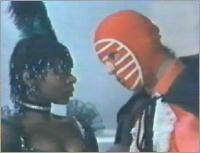 Kendo was to play the fictional masked superstar "Death Angel" whilst his arch enemy in the script, "Juggernaut", would be played by none other than Giant Haystacks. Among the all-star cast gathered together for the production were respected thespians Michael Elphick, Floella Benjamin and Anna Carteret, whilst those also to be seen from the wrestling world included Jim Breaks, Tony Walsh, and Brian Crabtree. What made this appearance so special to all of Kendo’s admirers was that for the first time ever Kendo would speak; he would still wear the famous mask, but his voice had never been heard in public before and it has never been heard since.
Kendo was to play the fictional masked superstar "Death Angel" whilst his arch enemy in the script, "Juggernaut", would be played by none other than Giant Haystacks. Among the all-star cast gathered together for the production were respected thespians Michael Elphick, Floella Benjamin and Anna Carteret, whilst those also to be seen from the wrestling world included Jim Breaks, Tony Walsh, and Brian Crabtree. What made this appearance so special to all of Kendo’s admirers was that for the first time ever Kendo would speak; he would still wear the famous mask, but his voice had never been heard in public before and it has never been heard since.
Filmed at the legendary King’s Hall, Belle Vue in Manchester (now sadly demolished) the play was applauded by the critics when it was shown a few months later. Kendo turned in a accomplished performance, but he returned to his silent world as soon as filming had ended. His one concession to breaking this code now over, Kendo would continue to be heard only through George Gillett. Many followers had never thought they would ever hear Kendo, but the next move by the victorious twosome was to take the whole of the wrestling world completely by surprise: Kendo Nagasaki, it was announced, was planning to voluntarily unmask...

